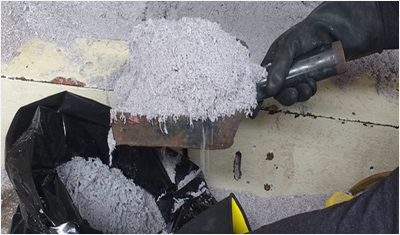Thermal, chemical and mechanical characterization of a flexible compound made from wet blue shavings from the tanning industry
DOI:
https://doi.org/10.56926/repia.v2i1.33Keywords:
tensile test, composite material, thermoplastic matrix, recycling, wet blue chipAbstract
The objective of the work was to use the wet blue leather shaving as a reinforcing material for the elaboration of a thermoplastic behavior polymer matrix composite material, which was thermally, chemically, and mechanically characterized. Six variables were measured: chip size, chip/resin ratio, percentage of water, resin temperature, pressure, and pressure time, to evaluate the tensile strength. A fractional factorial design was applied and leather sheets were made using wet blue-chip waste, Vinnapas ®400 thermoplastic resin, and distilled water. The main variable on the maximum tensile strength is given by the Chip/Resin ratio at its minimum value, followed by the chip size variable at its maximum value. The highest tensile strength value was 2,657 MPa. Young's modulus indicated that the highest value corresponds to combination #10 where 28.17 MPa were obtained. The TGA technique shows that the new material shows up to 10% presence of recycled material. The results indicate that new materials can be obtained from industrial waste products, which with proper treatment could be used for different industrial purposes.
Downloads
References
Cosavalente, F. I. (2019). Perú: Situación actual del sector cuero y calzado. IV Congreso Nacional de Cuero y Calzado. Lima 2019. 47p.
Jacob Moses, A., Goutham Murari, V. P., & Balamurugan, S. (2014). Experimental analysis of mechanical behavior of Industrial waste filled polymer composite. International Journal of Latest Trends in Engineering and Technology (IJLTET), 3(4), 114–117. https://www.ijltet.org/journal_details.php?id=891&j_id=2319
Kale, R. D., & Jadhav, N. C. (2019). Utilization of waste leather for the fabrication of composites and to study its mechanical and thermal properties. SN Applied Sciences, 1(10), 1231. https://doi.org/10.1007/s42452-019-1230-9
Liu, Y., Wang, Q., & Li, L. (2016). Reuse of leather shavings as a reinforcing filler for poly (vinyl alcohol). Journal of Thermoplastic Composite Materials, 29(3), 327–343. https://doi.org/10.1177/0892705713518794
Senthil, R., Hemalatha, T., Kumar, B. S., Uma, T. S., Das, B. N., & Sastry, T. P. (2015). Recycling of finished leather wastes: a novel approach. Clean Technologies and Environmental Policy, 17(1), 187–197. https://doi.org/10.1007/s10098-014-0776-x
Urrego Yepes, W., Cardona, N., Velasquez, S. M., Giraldo Vásquez, D. H., & Posada, J. C. (2019). Mechanical and rheometric properties of natural rubber composites filled with untreated and chemically treated leather wastes. Journal of Composite Materials, 53(11), 1475–1487. https://doi.org/10.1177/0021998318805195

Published
How to Cite
Issue
Section
License
Copyright (c) 2023 Edgard David Mollehuanca-Caballero, José Alberto Aguilar-Franco, Holger Saúl Pérez-Montaño

This work is licensed under a Creative Commons Attribution 4.0 International License.
Authors retain their rights:
a. The authors retain the intellectual property rights (copyright) of the published works, assigning to the journal the right of first publication.
b. Authors retain their trademark and patent rights, and also on any process or procedure described in the article.
c. Authors retain the right to share, copy, distribute, perform and publicly communicate the article published in REPIA (e.g., place it in an institutional repository or publish it in a book), with an acknowledgement of its initial publication in REPIA.
d. Authors retain the right to make a subsequent publication of their work, to use the article or any part of it (e.g., a compilation of their work, notes for conferences, theses, or for a book), provided they indicate the source of publication (authors of the work, journal, volume, number, and date).







